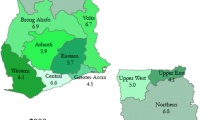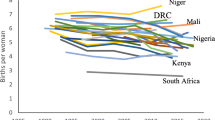Abstract
We use detailed measures of social change over time, increased availability of various health services, and couples’ fertility behaviors to document the independent effects of health services on fertility limitation. Our investigation focuses on a setting in rural Nepal that experienced a transition from virtually no use of birth control in 1945 to the widespread use of birth control by 1995 to limit fertility. Changes in the availability of many different dimensions of health services provide the means to evaluate their independent influences on contraceptive use to limit childbearing. Findings show that family planning as well as maternal and child health services have independent effects on the rate of ending childbearing. For example, the provision of child immunization services increases the rate of contraceptive use to limit fertility independently of family planning services. Additionally, new Geographic Information System (GIS)-based measures also allow us to test many alternative models of the spatial distribution of services. These tests reveal that complex, geographically defined measures of all health service providers outperform more simple measures. These results provide new information about the consequences of maternal and child health services and the importance of these services in shaping fertility transitions.
Similar content being viewed by others
References
Acharya, M. and L. Bennett. 1981. Rural Women of Nepal: An Aggregate Analysis and Summary of Eight Village Studies. Kathmandu: Tribhuvan University.
Allison, P.D. 1982. “Discrete-Time Methods for the Analysis of Event Histories.” Sociological Methodology 13:61–98.
—. 1984. Event History Analysis. Newbury Park, CA: Sage Publishing.
Angeles, G., D.K. Guilkey, and T.A. Mroz. 1998. “Purposive Program Placement and the Estimation of Family Planning Program Effects in Tanzania.” Journal of the American Statistical Association 93(443):884–99.
Arends-Kuenning, M. 2001. “How Do Family Planning Workers’ Visits Affect Women’s Contraceptive Behavior in Bangladesh?” Demography 38:481–96.
Axinn, W.G. 1992a. “Family Organization and Fertility Limitation in Nepal.” Demography 29:503–21.
—. 1992b. “Rural Income-Generating Programs and Fertility Limitation: Evidence From a Microdemographic Study in Nepal.” Rural Sociology 57:396–413.
Axinn, W.G. and J.S. Barber. 2001. “Mass Education and Fertility Transition.” American Sociological Review 66:481–505.
Axinn, W.G., J.S. Barber, and D.J. Ghimire. 1997. “The Neighborhood History Calendar: A Data Collection Method Designed for Dynamic Multilevel Modeling.” Sociological Methodology 27:355–92.
Axinn, W.G., L.D. Pearce, and D.J. Ghimire. 1999. “Innovations in Life History Calendar Applications.” Social Science Research 28:243–64.
Axinn, W.G. and S.T. Yabiku. 2001. “Social Change, the Social Organization of Families, and Fertility Limitation.” American Journal of Sociology 106:1219–61.
Barber, J.S. and W.G. Axinn. 2004. “New Ideas and Fertility Limitation: The Role of Mass Media.” Journal of Marriage and Family 66:1180–200.
Barber, J.S., S.A. Murphy, W.G. Axinn, and J. Maples. 2000. “Discrete-Time Multilevel Hazard Analysis.” Sociological Methodology 30:201–35.
Barber, J.S., S.A. Murphy, and N. Verbitsky. 2004. “Adjusting for Time-Varying Confounding in Survival Analysis.” Sociological Methodology 34:163–92.
Becker, G.S. 1981. A Treaties on the Family. Cambridge, MA: Harvard University Press.
Billy, J.O.G., K.L. Brewster, and W.R. Grady. 1994. “Contextual Effects on the Sexual Behavior of Adolescent Women.” Journal of Marriage and the Family 56:387–404.
Bista, D.B. 1972. People of Nepal. Kathmandu: Ratna Pustak Bhandar.
Boardman, J.D. and S.H. Field. 2002. “Spatial Mismatch and Race Differentials in Male Joblessness: Cleveland and Milwaukee, 1990.” Sociological Quarterly 43:237–55.
Bongaarts, J. and J. Menken. 1983. “The Supply of Children: A Critical Essay.” Pp. 27–60 in Determinants of Fertility in Developing Countries, Vol. 1, edited by R.A. Bulatao and R.D. Lee. New York: Academic Press.
Brewster, K.L., J.O.G. Billy, and W.R. Grady. 1993. “Social Context and Adolescent Behavior: The Impact of Community on the Transition to Sexual Activity.” Social Forces 71:713–40.
Brooks-Gunn, J., G.J. Duncan, P.K. Klebanov, and N. Sealand. 1993. “Do Neighborhoods In uence Child and Adolescent Development?” American Journal of Sociology 99:353–95.
Browning, C.R., T. Leventhal, and J. Brooks-Gunn. 2004. “Neighborhood Context and Racial Differences in Early Adolescent Sexual Activity.” Demography 41:697–720.
Bulatao, R.A. and R.D. Lee. 1983. Determinants of Fertility in Developing Countries. New York: Academic Press.
Buor, D. 2002. “Distance As a Predominant Factor in the Utilization of Health Services in the Kumasi Metropolis, Ghana.” GeoJournal 56:145–57.
—. 2003. “Analysing the Primacy of Distance in the Utilization of Health Services in the Ahafo-Ano South District, Ghana.” International Journal of Health Planning and Management 18:293–311.
Caldwell, J.C. 1982. Theory of Fertility Decline. New York: Academic Press.
—. 1986. “Routes to Low Mortality in Poor Countries.” Population and Development Review 12:171–220.
Caldwell, J.C., P.H. Reddy, and P. Caldwell. 1988. The Causes of Demographic Change: Experimental Evidence Research in South India. Madison: University of Wisconsin Press.
Casterline, J.B. 1985. The Collection and Analysis of Community Data. Voorburg, Netherlands: International Statistics Institute.
—. 2001. “Diffusion Processes and Fertility Transition: Introduction.” Pp. 1–16 in Diffusion Processes and Fertility Transition, edited by J.B. Casterline. Washington, DC: National Academy Press.
Casterline, J.B. and S.W. Sinding. 2000. “Unmet Need for Family Planning in Developing Countries and Implications for Population Policy.” Population and Development Review 26:691–723.
Chen, L.C. 1983. “Child Survival: Levels, Trends, and Determinants.” Pp. 199–232 in Determinants of Fertility in Developing Countries, Vol. 1, edited by R.A. Bulatao and R.D. Lee. New York: Academic Press.
Cleland, J. and J. Hobcraft. 1985. Reproductive Change in Developing Countries: Insights From the World Fertility Survey. Oxford: Oxford University Press.
Coale, A.J. 1973. “The Demographic Transition.” International Union for the Scientific Study of Population, International Population Conference 1:53–72.
Coale, A.J. and S.C. Watkins, eds. 1986. The Decline of Fertility in Europe. Princeton, NJ: Princeton University Press.
Downey, L. 2006. “Using Geographic Information Systems to Reconceptualize Spatial Relationships and Ecological Context.” American Journal of Sociology 112:567–612.
Easterlin, R. and E. Crimmins. 1985. “Theoretical Framework.” Pp. 12–31 in The Fertility Revolution: A Supply-Demand Analysis, edited by R.A. Easterlin and E.M. Crimmins. Chicago: University of Chicago Press.
Entwisle, B. and W.M. Mason. 1985. “Multilevel Effects of Socioeconomic Development and Family Planning Programs on Children Ever Born.” American Journal of Sociology 91:616–49.
Entwisle, B., R.R. Rindfuss, D.K. Guilkey, A. Chamratrithirong, S.R. Curran, and Y. Sawangdee. 1996. “Community and Contraceptive Choice in Rural Thailand: A Case Study of Nang Rong.” Demography 33:1–11.
Entwisle, B., R.R. Rindfuss, S.J. Walsh, T.P. Evans, and S.R. Curran. 1997. “Geographic Information Systems, Spatial Network Analysis, and Contraceptive Choice.” Demography 34:171–87.
Foster, S.O. 1984. “Immunizable and Respiratory Diseases and Child Mortality.” Population and Development Review 10(Suppl.: Child Survival: Strategies for Research):119–40.
Frankenberg, E. and D. Thomas. 2001. “Women’s Health and Pregnancy Outcomes: Do Services Make a Difference?” Demography 38:253–365.
Freedman, R. 1979. “Theories of Fertility Decline: A Reappraisal.” Social Forces 58:1–17.
—. 1997. “Do Family Planning Programs Affect Fertility Preferences? A Literature Review.” Studies in Family Planning 28(1):1–13.
Freedman, R. and J.Y. Takeshita. 1969. Family Planning in Taiwan: An Experiment in Social Change. Princeton, NJ: Princeton University Press.
Fricke, T.E. 1986. Himalayan Households: Tamang Demography and Domestic Processes. Ann Arbor, MI: UMI Research Press.
Gertler, P.J. and J.W. Molyneaux. 1994. “How Economic-Development and Family-Planning Programs Combined to Reduce Indonesian Fertility.” Demography 31:33–63.
Gurung, H.B. 1980. Vignettes of Nepal. Kathmandu: Sajha Prakashan.
Hermalin, A. and B. Entwisle. 1987. “The Availability and Accessibility of Contraceptive Services.” Pp. 583–96 in Organizing for Effective Family Planning Programs, edited by R. Lapham and G.B. Simmons. Washington, DC: National Academy Press.
Hernandez, D.J. 1981. “A Note on Measuring the Independent Impact of Family Planning Programs on Fertility Declines.” Demography 18:627–34.
Hogan, D.P. and E.M. Kitagawa. 1985. “The Impact of Social Status, Family Structure, and Neighborhood on the Fertility of Black Adolescents.” American Journal of Sociology 90: 825–55.
Justice, J. 1986. Polices, Plans and People: Culture and Health Development in Nepal. Berkeley: University of California Press.
Knodel, J., A. Chamratrithirong, and N. Debavalya. 1987. Thailand’s Reproductive Revolution: Rapid Fertility Decline in a Third-World Setting. Madison: University of Wisconsin Press.
Koenig, M.A., J.F. Phillips, R.S. Simmons, and M.A. Khan. 1987. “Trends in Family-Size Preferences and Contraceptive Use in Matlab, Bangladesh.” Studies in Family Planning 18(3):117–27.
Lesthaeghe, R. and J. Surkyn. 1988. “Cultural Dynamics and Economic Theories of Fertility Change.” Population and Development Review 14(1):1–45.
Lloyd, C.B. and S. Ivanov. 1988. “The Effects of Improved Child Survival on Family Planning Practice and Fertility.” Studies in Family Planning 19(3):141–61.
Mason, K.O. 1987. “The Impact of Women’s Social Position on Fertility in Developing Countries.” Sociological Forum 2:718–45.
—. 1997. “Explaining Fertility Transitions.” Demography 34:443–54.
—. 2001. “Gender and Family Systems in the Fertility Transition.” Population and Development Review 27(Global Fertility Transition supplement):160–76.
Massey, D.S. and K.E. Espinosa. 1997. “What’s Driving Mexico-U.S. Migration? A Theoretical, Empirical, and Policy Analysis.” American Journal of Sociology 102:939–99.
Ministry of Health. 1977. Nepal Fertility Survey 1976. Kathmandu: His Majesty’s Government and World Fertility Survey/Nepal Project.
—. 2004. Annual Report. Kathmandu: His Majesty’s Government, Ministry of Health, Department of Health Services.
Montgomery, M.R. 2000. “Perceiving Mortality Decline.” Population and Development Review 26:795–819.
Morenoff, J.D., R.J. Sampson, and S.W. Raudenbush. 2001. “Neighborhood Inequality, Collective Efficacy, and the Spatial Dynamics of Urban Violence.” Criminology 39:517–59.
Muhuri, P.K. 1995. “Health Programs, Maternal Education, and Differential Child Mortality in Mat-lab, Bangladesh.” Population and Development Review 21:813–34.
Nepal South Asia Center. 1998. Nepal Human Development Report 1998. Kathmandu, Nepal: Nepal South Asia Center.
Palmore, J. and R. Freedman. 1969. “Perceptions of Contraceptive Practice By Others: Effects on Acceptance.” Pp. 224–40 in Family Planning in Taiwan: An Experiment in Social Change, edited by R. Freedman and J.Y. Takeshita. Princeton, NJ: Princeton University Press.
Pebley, A.R. 1984. “Intervention Projects and the Study of Socioeconomic Determinants of Mortality.” Population and Development Review 10(Suppl.: Child Survival: Strategies for Research): 281–305.
Petersen, T. 1986. “Estimating Fully Parametric Hazard Rate Models With Time-Dependent Covariates: Use of Maximum Likelihood.” Sociological Methods and Research 14:219–46.
—. 1991. “The Statistical Analysis of Event Histories.” Sociological Methods and Research 19:270–323.
Phillips, J.F., W.S. Stinson, S. Bhatia, M. Rahman, and J. Chakraborty. 1982. “The Demographic Impact of the Family Planning—Health Services Project in Matlab, Bangladesh.” Studies in Family Planning 13(5):131–40.
Raudenbush, S.W. 1988. “Educational Applications of Hierarchical Linear Models: A Review.” Journal of Educational Statistics 13:85–116.
Sandberg, J. 2002. “Child Mortality, Family Building and Social Learning in a Nepalese Mountain Community.” Ph.D. dissertation. Department of Sociology, The University of Michigan, Ann Arbor, MI.
—. 2006. “Infant Mortality, Social Networks, and Subsequent Fertility.” American Sociological Review 71:288–309.
Sastry, N. 1996. “Community Characteristics, Individual and Household Attributes, and Child Survival in Brazil.” Demography 33:211–29.
South, S.J. and K.D. Crowder. 1997. “Escaping Distressed Neighborhoods: Individual, Community, and Metropolitan In uences.” American Journal of Sociology 102:1040–84.
Stash, S. 1999. “Explanations of Unmet Need for Contraception in Chitwan, Nepal.” Studies in Family Planning 30:267–87.
Suvedi, B.K. 2003. “Immunization Programme of Nepal: An Update.” Kathmandu University Medical Journal 2(3):238–43.
Thornton, A. 2005. Reading History Sideways: The Fallacy and Enduring Impact of the Developmental Paradigm on Family Life. Chicago: University of Chicago Press.
Thornton, A. and H.-S. Lin. 1994. Social Change and the Family in Taiwan. Chicago: University of Chicago Press.
Tuladhar, J.M. 1989. The Persistence of High Fertility in Nepal. New Dehli: Inter-India Publications.
United Nations Population Fund. 1989. South Asia Study on Population Policies and Programmes: Nepal. United Nations.
Whyte, M.K. and W.L. Parish. 1984. Urban Life in Contemporary China. Chicago: University of Chicago Press.
Yabiku, S.T. 2004. “Marriage Timing in Nepal: Organizational Effects and Individual Mechanisms.” Social Forces 83:559–86.
Author information
Authors and Affiliations
Additional information
This research was supported by a grant from the National Institute of Child Health and Human Development (R01-HD32912) and the Fogarty International Center, International Training and Research Program in Population and Health. Paper presented at the regular session “Cross-National Perspectives on Fertility and Reproduction” at the annual meeting of the American Sociological Association, August 14–17, 2004. We would like to thank Jennifer Barber, Jennifer Johnston-Hanks, and Scott Yabiku for comments on earlier versions of this article; the staff of the Population and Ecological Research Laboratory, Rampur, Chitwan, Nepal for their assistance in data collection; and Paul Schulz for programming assistance. Any errors are the responsibility of the authors.
Rights and permissions
About this article
Cite this article
Brauner-Otto, S.R., Axinn, W.G. & Ghimire, D.J. The spread of health services and fertility Transition. Demography 44, 747–770 (2007). https://doi.org/10.1353/dem.2007.0041
Issue Date:
DOI: https://doi.org/10.1353/dem.2007.0041




